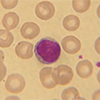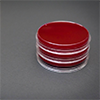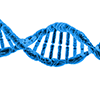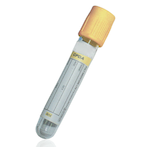
- Home
- Clinical Chemistry Tests
- Cholesterol
Cholesterol
Specimen Volume
5 mL vacutainerSample Preparation
Centrifuge
Turnaround Time
1 daySample Processing In Laboratory
UsualSample Stability
7 days at 2-8°C, 3 months at -20°C
General Information
Cholesterol measurement, alongside HDL, LDL and triglycerides, is used to diagnose and monitor hypercholesterolaemia (monogenic, polygenic and secondary), and to assess cardiovascular risk. In risk assessment, cholesterol measurements should be considered in relation to other risk factors (e.g. cigarette smoking, hypertension, diabetes mellitus, a personal history of cardiovascular disease etc). Raised concentrations should be confirmed with a repeat, together with measurements of other lipids including triglyceride and HDL-cholesterol, and LDL-cholesterol (usually by calculation).
Secondary causes of hypercholesterolaemia must be excluded before initiating specific treatment. Causes of secondary hyperlipidaemia include chronic liver disease (particularly with cholestasis), hypothyroidism, chronic kidney disease, myeloma, alcohol excess (particularly in connection with severe hypertriglyceridaemia), and drugs (steroids, retinoids, anti-retrovirals and tamoxifen can induce significant (usually mixed) hyperlipidaemia).
It is often recommended that diagnosis and treatment should not be based on individual measurements because of the relatively high biological variation.
Patient Preparation
Cholesterol is influenced by inflammation, and so it is better to avoid sampling when the presence of an acute phase response is likely to give misleading results. For example, cholesterol should be measured at the time of admission with chest pain rather than the following day, by which time the concentration may have dropped significantly. It is important to note that this suppression may last several months. Samples for lipids other than cholesterol are best taken after fasting to reduce the influence of recent dietary intake.
Notes
Clinical uses:
1. Screening for hypercholesterolaemia/dyslipidaemia. Concentrations should be interpreted as part of a global cardiovascular risk assessment (refer to https://www.nice.org.uk/guidance/cg181), unless particularly high, in which case other reasons of hypercholesterolaemia should be considered (e.g. familial hypercholesterolaemia: https://www.nice.org.uk/guidance/cg71).
2. Monitoring of treatment – most recommendations suggest treating to a target [cholesterol], particularly for patients with FH or existing cardiovascular disease; measurements are also used for assessing adherence to treatment.
Reference Range
The optimal cholesterol concentration for men and women is <4.0 mmol/L (Joint British Societies Guidelines). The National Service Frameworks for coronary disease recommend a reduction to <5.0 mmol/L for those who are treated for secondary prevention or primary prevention where their risk for cardiovascular disease is >20% over a 10 year period. It is often recommended that diagnosis and treatment should not be based on individual measurements because of the relatively high biological variation. Age, sex, pregnancy etc may affect results and appropriate ranges are reported.
Specifications
-
EQA Status:
NEQAS
- EQAS Scheme: Yes
Related Tests
HDL Cholesterol TriglyceridesCreation Date
Monday, 08 August 2011Modification Date
Tuesday, 10 March 2020General Information
Location of Laboratories
Copyright UHB Pathology 2018
Protection of Personal Information – Clinical Laboratory Services comply with the Trust Data Protection Policy and have procedures in place to allow the Directorate and it’s employees to comply with the Data Protection Act 1998 and associated best practice and guidance.
University Hospitals Birmingham medical laboratories at Queen Elizabeth Hospital, Heartlands Hospital, Good Hope Hospital and Solihull Hospital are UKAS (United Kingdom Accreditation Service) accredited to the ISO 15189:2012 standard. For a list of accredited tests and other information please visit the UKAS website using the following link: https://www.ukas.com/find-an-organisation/
- Molecular Pathology is a UKAS accredited medical laboratory No. 8759
- Biochemistry is a UKAS accredited medical laboratory No. 8910
- Haematology and Transfusion is a UKAS accredited medical laboratory No. 8784
- Clinical Microbiology is a UKAS accredited medical laboratory No. 8760
- Cellular Pathology is a UKAS accredited medical laboratory No. 10141
- Musculoskeletal laboratory is a UKAS accredited medical laboratory No. 9897
- Heartlands, Good Hope and Solihull Hospital pathology laboratories are a UKAS accredited medical laboratory No.8217.
Tests not appearing on the UKAS Schedule of Accreditation currently remain outside of our scope of accreditation. However, these tests have been validated to the same high standard as accredited tests and are performed by the same trained and competent staff.
For further test information, please visit the test database: http://qehbpathology.uk/test-database
For further information contact Louise Fallon, Quality Manager, 0121 371 5962
 Biochemistry
Biochemistry Haematology and Transfusion
Haematology and Transfusion Clinical Microbiology (Including Virology)
Clinical Microbiology (Including Virology) Cellular Pathology
Cellular Pathology General Information
General Information Molecular Pathology
Molecular Pathology